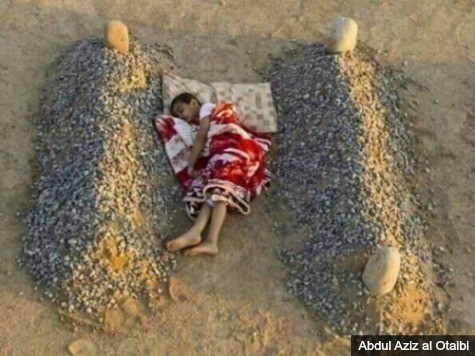
An image touted as that of an orphaned Syrian boy sleeping between the graves of his murdered parents has been sweeping through social media and is being used to decry the deteriorating situation in Bashar al-Asaad’s country. But it turns out that the photo is a hoax.
The photo depicts a boy wrapped in a woven blanket and sleeping between two six-foot long piles of stones resembling graves. Larger rocks appear at the head of each pile, completing the impression that the rubble could be graves.
The photo often appears with a headline or caption leading viewers to believe that this is an orphaned Syrian child that has lost his parents in the unrest there.
The truth, however, is that the image is a staged photo, the pile of pebbles merely that–a pile of pebbles–and the boy the nephew of the photographer and not an orphan at all.
Even more absurdly, the photo was taken in Saudi Arabia, not Syria.
The creator of the photo cannot be blamed for this propaganda. Abdul Aziz al Otaibi, a photographer from Saudi Arabia, has made it clear that he is quite upset that people have appropriated his image for a Syrian propaganda campaign.
Photographer al Otaibi has explained that he intended his photo to be art, not propaganda. As reported by Harold Doornbos, al Otaibi was trying to make an artistic statement about a child’s love for his parents.
“I love photography,” al Otaibi told Doornbos by phone. “Every artist has ideas in his head. So I had the idea to make a project whereby I show in pictures how the love of a child for his parents is irreplaceable. This love cannot be substituted by anything or anybody else, even if the parents are dead.”
Early in January, the photographer posted the image on his own Facebook page explaining clearly what his purpose for the image was and that it was a staged photo featuring his nephew. But, much to his chagrin, that didn’t stop those who decided to appropriate his photo to turn it into Syrian propaganda.
“I am really very annoyed by this,” al Otaibi said. “It is just not fair to take one of my photos totally out of context and use it for your own propaganda.”
This is all too common in the Middle East, unfortunately. In fact, some terror outfits–especially in the Palestinian territory–have special propaganda units geared specifically for making false photos and videos depicting fake attacks on their people. The photos and videos often show dead children to elicit sympathy from the outside world. Such images are sometimes called “Paliwood photos.”
The most famous fake video depicting the death of a Palestinian child was the case of one Muhammad al-Dura, a little boy supposedly killed by Israeli military forces. For years the fake video and image was used by western media outlets to malign the Israelis, but it was ultimately shown to be a fraud. In 2008 the photo and video was even the subject of a major court case of media bias against the government-controlled French media.
Only a few years ago, CNN’s Anderson Cooper was fooled into using another faked video of Palestinian “victims” in his reporting.

COMMENTS
Please let us know if you're having issues with commenting.